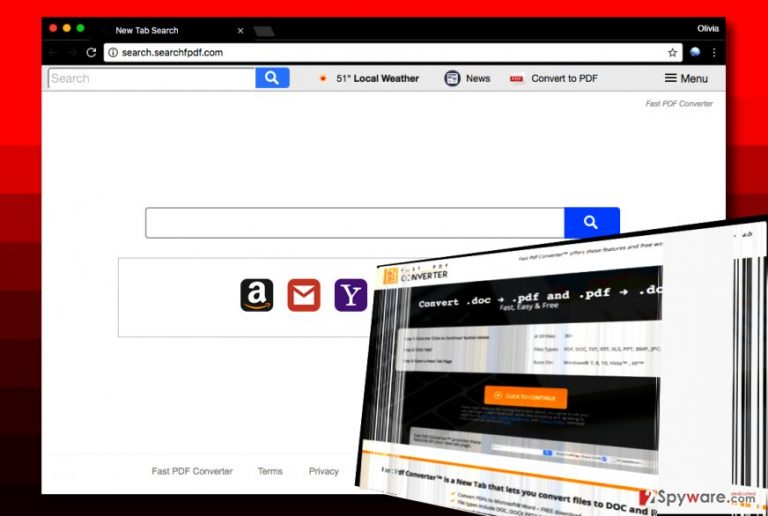Search.searchfpdf.com virus (Removal Guide) - Chrome, Firefox, IE, Edge
Search.searchfpdf.com virus Removal Guide
What is Search.searchfpdf.com virus?
Untrustworthy Search.searchfpdf.com search engine serves modified results that can contain links to shady external sites
Search.searchfpdf.com is a deceptive web page that becomes user’s homepage and default search provider as soon as the victim installs Fast PDF Converter. This suspicious piece of software is considered to be a potentially unwanted program (PUP) that initiates redirects to hxxp://Search.searchfpdf.com/ page even when the victim has no intention to do so. This PUP belongs to browser hijacker category, and such programs typically promote particular search tool that is set to provide sponsored entries alongside regular search results. Now, we must say that such mixture of sponsored and organic search results can be dangerous. The developer of Searchpdf redirect virus[1] does not endorse content shared by sites that it advertises, and that means you can easily enter dangerous web pages simply by browsing through results brought by this questionable search tool. The primary aim of the hijacker is to convince unsuspecting users to use a particular search engine and make them click on results that it serves. As we have already said, such move can immediately cause a redirect to an external website that has a bad reputation[2]. For this reason, we typically recommend users to remove Search.searchfpdf.com before it is too late. This shady PC parasite can be easily eliminated manually or automatically. For more information about Search.searchfpdf removal, we suggest looking at instructions given at the end of this post.

Another disadvantage of this hijacker is that it aims to collect behavioral information about the user. To be precise, it seeks to collect user’s search queries, websites that the victim visits, sites that he/she accesses frequently, ads and links one clicks on, and similar data. Although such information is not considered to be personally identifiable, keep in mind that your search queries can disclose who you are. You do not know how developers of this potentially unwanted program store such information and who can access it. Data stored on company’s computers can be illegally accessed and stolen. It is very easy to misuse such data, so we do not think that you should rely on this program that is considered to be potentially unwanted one. If you are a security-minded computer user, take actions to get rid of this virtual parasite right now.

Distribution tricks used by spyware developers
Browser hijackers, adware and other suspicious programs are classified as spyware, and these programs are mostly distributed using software bundling. Software bundling can be compared to software grouping and packing. Let’s say you just decided to download a new media player from the Internet for free – you search the web for it, enter a website that provides its download link, you get the file and then launch the installer of the desired software. At this point, you should NOT begin clicking the “Next” button repeatedly. Pay close attention to the information provided by the installer. If it says that you agree to install “recommended” programs, remove checkmarks placed next to such agreements. Sadly, such statements are often concealed under Default/Standard settings, so in order to alter your permissions, you will need to switch the selection to Custom/Advanced mode.
Quick Search.searchfpdf.com removal tutorial
We are sure that you have been looking for Search.searchfpdf.com removal tutorial if you came across this website. Look no further – the guide provided below explains how to find and remove Search.searchfpdf.com virus remains. If you cannot understand something, feel free to contact our support team and ask us to assist you. Do not delay the removal because as long as this suspicious program stays on the computer system, the computer stays vulnerable to further spyware and malware attacks.
You may remove virus damage with a help of FortectIntego. SpyHunter 5Combo Cleaner and Malwarebytes are recommended to detect potentially unwanted programs and viruses with all their files and registry entries that are related to them.
Getting rid of Search.searchfpdf.com virus. Follow these steps
Uninstall from Windows
Use the provided instructions to access currently installed software list and uninstall all shady programs that you think might be related to Search.searchfpdf.
Instructions for Windows 10/8 machines:
- Enter Control Panel into Windows search box and hit Enter or click on the search result.
- Under Programs, select Uninstall a program.

- From the list, find the entry of the suspicious program.
- Right-click on the application and select Uninstall.
- If User Account Control shows up, click Yes.
- Wait till uninstallation process is complete and click OK.

If you are Windows 7/XP user, proceed with the following instructions:
- Click on Windows Start > Control Panel located on the right pane (if you are Windows XP user, click on Add/Remove Programs).
- In Control Panel, select Programs > Uninstall a program.

- Pick the unwanted application by clicking on it once.
- At the top, click Uninstall/Change.
- In the confirmation prompt, pick Yes.
- Click OK once the removal process is finished.
Delete from macOS
Remove items from Applications folder:
- From the menu bar, select Go > Applications.
- In the Applications folder, look for all related entries.
- Click on the app and drag it to Trash (or right-click and pick Move to Trash)

To fully remove an unwanted app, you need to access Application Support, LaunchAgents, and LaunchDaemons folders and delete relevant files:
- Select Go > Go to Folder.
- Enter /Library/Application Support and click Go or press Enter.
- In the Application Support folder, look for any dubious entries and then delete them.
- Now enter /Library/LaunchAgents and /Library/LaunchDaemons folders the same way and terminate all the related .plist files.

Remove from Microsoft Edge
Delete unwanted extensions from MS Edge:
- Select Menu (three horizontal dots at the top-right of the browser window) and pick Extensions.
- From the list, pick the extension and click on the Gear icon.
- Click on Uninstall at the bottom.

Clear cookies and other browser data:
- Click on the Menu (three horizontal dots at the top-right of the browser window) and select Privacy & security.
- Under Clear browsing data, pick Choose what to clear.
- Select everything (apart from passwords, although you might want to include Media licenses as well, if applicable) and click on Clear.

Restore new tab and homepage settings:
- Click the menu icon and choose Settings.
- Then find On startup section.
- Click Disable if you found any suspicious domain.
Reset MS Edge if the above steps did not work:
- Press on Ctrl + Shift + Esc to open Task Manager.
- Click on More details arrow at the bottom of the window.
- Select Details tab.
- Now scroll down and locate every entry with Microsoft Edge name in it. Right-click on each of them and select End Task to stop MS Edge from running.

If this solution failed to help you, you need to use an advanced Edge reset method. Note that you need to backup your data before proceeding.
- Find the following folder on your computer: C:\\Users\\%username%\\AppData\\Local\\Packages\\Microsoft.MicrosoftEdge_8wekyb3d8bbwe.
- Press Ctrl + A on your keyboard to select all folders.
- Right-click on them and pick Delete

- Now right-click on the Start button and pick Windows PowerShell (Admin).
- When the new window opens, copy and paste the following command, and then press Enter:
Get-AppXPackage -AllUsers -Name Microsoft.MicrosoftEdge | Foreach {Add-AppxPackage -DisableDevelopmentMode -Register “$($_.InstallLocation)\\AppXManifest.xml” -Verbose

Instructions for Chromium-based Edge
Delete extensions from MS Edge (Chromium):
- Open Edge and click select Settings > Extensions.
- Delete unwanted extensions by clicking Remove.

Clear cache and site data:
- Click on Menu and go to Settings.
- Select Privacy, search and services.
- Under Clear browsing data, pick Choose what to clear.
- Under Time range, pick All time.
- Select Clear now.

Reset Chromium-based MS Edge:
- Click on Menu and select Settings.
- On the left side, pick Reset settings.
- Select Restore settings to their default values.
- Confirm with Reset.

Remove from Mozilla Firefox (FF)
Firefox browser should contain an extension called Fast PDF Converter. Find and delete it!
Remove dangerous extensions:
- Open Mozilla Firefox browser and click on the Menu (three horizontal lines at the top-right of the window).
- Select Add-ons.
- In here, select unwanted plugin and click Remove.

Reset the homepage:
- Click three horizontal lines at the top right corner to open the menu.
- Choose Options.
- Under Home options, enter your preferred site that will open every time you newly open the Mozilla Firefox.
Clear cookies and site data:
- Click Menu and pick Settings.
- Go to Privacy & Security section.
- Scroll down to locate Cookies and Site Data.
- Click on Clear Data…
- Select Cookies and Site Data, as well as Cached Web Content and press Clear.

Reset Mozilla Firefox
If clearing the browser as explained above did not help, reset Mozilla Firefox:
- Open Mozilla Firefox browser and click the Menu.
- Go to Help and then choose Troubleshooting Information.

- Under Give Firefox a tune up section, click on Refresh Firefox…
- Once the pop-up shows up, confirm the action by pressing on Refresh Firefox.

Remove from Google Chrome
Open Chrome browser and, using instructions provided below, find and delete Fast PDF Converter extension.
Delete malicious extensions from Google Chrome:
- Open Google Chrome, click on the Menu (three vertical dots at the top-right corner) and select More tools > Extensions.
- In the newly opened window, you will see all the installed extensions. Uninstall all the suspicious plugins that might be related to the unwanted program by clicking Remove.

Clear cache and web data from Chrome:
- Click on Menu and pick Settings.
- Under Privacy and security, select Clear browsing data.
- Select Browsing history, Cookies and other site data, as well as Cached images and files.
- Click Clear data.

Change your homepage:
- Click menu and choose Settings.
- Look for a suspicious site in the On startup section.
- Click on Open a specific or set of pages and click on three dots to find the Remove option.
Reset Google Chrome:
If the previous methods did not help you, reset Google Chrome to eliminate all the unwanted components:
- Click on Menu and select Settings.
- In the Settings, scroll down and click Advanced.
- Scroll down and locate Reset and clean up section.
- Now click Restore settings to their original defaults.
- Confirm with Reset settings.

Delete from Safari
Remove unwanted extensions from Safari:
- Click Safari > Preferences…
- In the new window, pick Extensions.
- Select the unwanted extension and select Uninstall.

Clear cookies and other website data from Safari:
- Click Safari > Clear History…
- From the drop-down menu under Clear, pick all history.
- Confirm with Clear History.

Reset Safari if the above-mentioned steps did not help you:
- Click Safari > Preferences…
- Go to Advanced tab.
- Tick the Show Develop menu in menu bar.
- From the menu bar, click Develop, and then select Empty Caches.

After uninstalling this potentially unwanted program (PUP) and fixing each of your web browsers, we recommend you to scan your PC system with a reputable anti-spyware. This will help you to get rid of Search.searchfpdf.com registry traces and will also identify related parasites or possible malware infections on your computer. For that you can use our top-rated malware remover: FortectIntego, SpyHunter 5Combo Cleaner or Malwarebytes.
How to prevent from getting stealing programs
Access your website securely from any location
When you work on the domain, site, blog, or different project that requires constant management, content creation, or coding, you may need to connect to the server and content management service more often. The best solution for creating a tighter network could be a dedicated/fixed IP address.
If you make your IP address static and set to your device, you can connect to the CMS from any location and do not create any additional issues for the server or network manager that needs to monitor connections and activities. VPN software providers like Private Internet Access can help you with such settings and offer the option to control the online reputation and manage projects easily from any part of the world.
Recover files after data-affecting malware attacks
While much of the data can be accidentally deleted due to various reasons, malware is one of the main culprits that can cause loss of pictures, documents, videos, and other important files. More serious malware infections lead to significant data loss when your documents, system files, and images get encrypted. In particular, ransomware is is a type of malware that focuses on such functions, so your files become useless without an ability to access them.
Even though there is little to no possibility to recover after file-locking threats, some applications have features for data recovery in the system. In some cases, Data Recovery Pro can also help to recover at least some portion of your data after data-locking virus infection or general cyber infection.
- ^ Jake Doevan. Browser redirect virus. How to remove? (Uninstall guide). 2-Spyware. Fighting against Spyware.
- ^ How do I avoid dangerous websites?. Lifewire. Tech Untangled.
